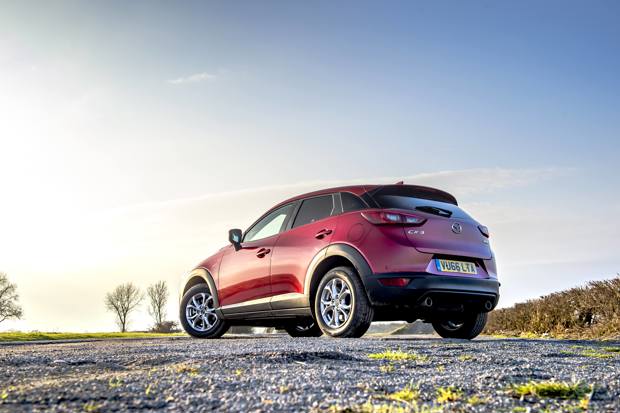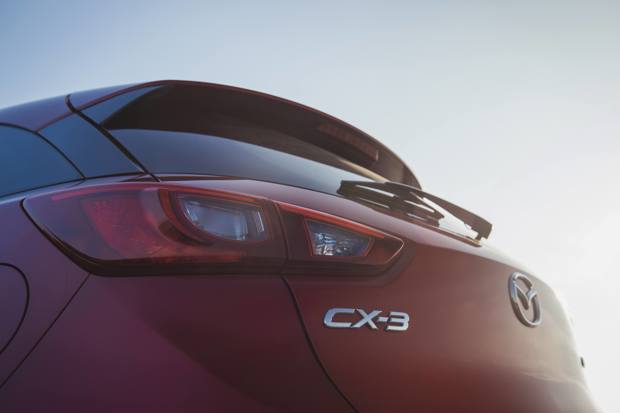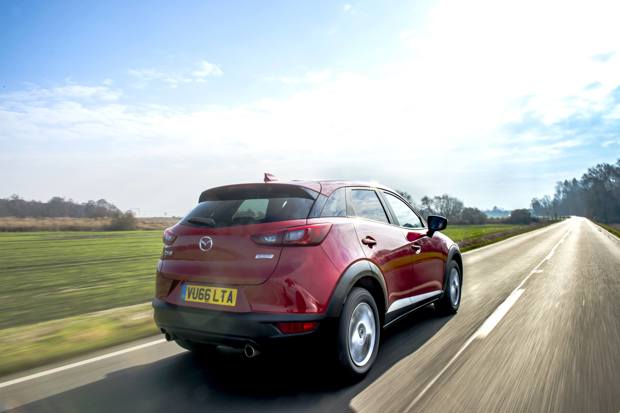Mazda CX-3 2.0-litre SE-L


First few days with the CX-3
There's a rapidly growing choice of small crossovers and the Mazda CX-3 is one of the picks of the bunch.

Date: 16 February 2017 | Current mileage: 1050 | Claimed economy: 47.9mpg | Actual economy: 43.2mpg
The Mazda CX-3 is the product of two trends that have been emerging for some time, but have accelerated over the course of the past few years.
The first of those is that small cars have been getting larger and larger. That’s nothing new, of course, they’ve just take a look at today’s Volkswagen Polo and park it next to a Volkswagen Golf. Both Polo and Golf have got larger and larger as the generations have passed. The result? The current Polo is larger than the original Golf and so large that a gap opened up for the Lupo (and subsequently Fox and Up) to be introduced.
The second trend is the crossover, established by the Nissan Qashqai in 2008. Nearly every manufacturer now has one in its line-up and they’ve also been morphing. They began life as a ‘crossover’ between a family car and an SUV, but have started cropping up in other sectors. So now you can find a crossover between an executive car and an SUV (like the BMW X4, a premium hatchback and an SUV (the Audi Q3) and, the most common, a small car and a small SUV.
And that’s the category the Mazda CX-3 drops into. It’s the same kind of idea as the Nissan Juke, Peugeot 2008 and Ford EcoSport … but to my eyes it’s the best looking of the lot. Whereas the Juke, with its sharp styling and exaggerated features has never looked quite right and the Peugeot 2008 is plain, the CX-3 strikes a superb balance between looking distinctive and modern, without going over the top.
I’ve gone for for the popular 2.0-litre SE-L NAV, as it’s an engine and specification that many buyers go for. The 2.0-litre engine with 120bhp should be should be quick enough around town and fine for the motorway, without going over the top. On paper, the figures look good, with 60mph achievable in just nine seconds and - for what it’s worth - a top speed of 119mph. There’s the option of a second 2.0-litre variant with 150bhp that reduces the 0-60mph time to under nine seconds and adds four-wheel drive, but with increased emissions and a higher price tag it’s rather unnecessary for my needs.

SE-L Nav trim has nav. Of course.
Likewise the SE-L NAV spec delivers all the goodies you need, without being over the top. So, as the name suggests, there’s satellite navigation (yes, I know it’s cheaper and just as easy to have a Garmin or Tom Tom, but it’s too much of a faff for me and I’m likely to take it out of a car and leave it somewhere…), as well as other goodies like DAB radio (which, despite becoming standard-fit, I’m always pleased to see and can’t live without) heated seats for the Winter months and air conditioning for when it gets warmer. Across the range equipment levels compare well to rivals and many of the CX-3’s standard features are expensive options elsewhere.
Price-wise it comes in at just under £20,000 (£19,825 to be precise), which is pretty decent value. Not cheap, by any means, but it’s smart, well built and has plenty of kit. Most people are buying their cars on a PCP deal these days. Again, the CX-3 is pretty competitive. A Mazda dealer is likely to offer a package at under four per cent APR which, when coupled with a decent deposit, means it could cost you less than £200 per month. Not for everyone, of course as there are restrictions like being limited to 9000 miles per year, but if you have a monthly amount in mind and want to keep costs down, it’s attractive. For comparison, a car loan with Nationwide Building Society will match the Mazda dealer APR (3.9 per cent), but monthly payments will be £471 per month. You would, of course, own the car at the end.
And, now that it’s been on sale for 18 months, decent used ones are beginning to appear on forecourts. Prices are currently sitting between £16,500 and £19,000 for the same spec as mine, depending on age and mileage.
New road tax rates - what’s the impact on CX-3?
Changing rules mean that the amount of road tax you pay is changing - but how does it affect the Mazda CX-3?

Date: 15 March 2017 | Current mileage: 1229 | Claimed economy: 47.9mpg | Actual economy: 43.4mpg
It’s been on the cards for a while, but it’s finally happening. From the start of April road tax rates are changing and some cars will be worse affected than others. Which got me thinking - what about my CX-3?
As it currently stands, my CX-3 is registered under what will be the ‘old’ system. The Road Tax change has caused much confusion, not least that everyone’s Road Tax is NOT changing. The new ‘flat rate’ system only applies to cars registered from 1 April 2017. Although cars registered under the current system will go up from time-to-time - largely in line with inflation - they will not be transferred onto these new rates.
For all the stories that have been run in recent weeks about small cars losing out under the new system, it’s largely ‘as you were’ for my CX-3. Under the present system, this CX-3 with emissions of 137g/km falls into Band E. Not as low as you may expect. It means an annual bill of £135.00 per year (or £74.25 every six months, £70.88 as six-monthly direct debits or £11.81 as a monthly direct debit). The new system only has two main bands - those above and below a list price of £40,000. As the CX-3 is well below that threshold it qualifies for the £140.00 rate. An increase of just £5 for the year - hardly enough to make you think twice before purchasing one.
It’s a bigger jump elsewhere in the range, as this is a policy change that’s harsh on diesel-powered cars. Opt for the 1.5D - with 105g/km of CO2 and you’ve got a Band B car and a Road Tax bill of just £20 per year. Buy that car after 1 April 2017 and you’re looking at an increase of £120 per year - almost £500 over four years and the sort of amount that makes you think twice about what you’re buying.

Will tax rule changes lead to more realistic economy figures?
But the CX-3 isn’t alone in suddenly being less attractive on road tax. Just take a look at the Nissan Juke. It’s a very familiar story. Its 1.5 dCi diesel engine produces 104g/km CO2 (incredibly close to the diesel CX-3), plonking it into tax band B and £20 per year. But, under the new system it’s up at £140 per year. And that pattern is repeated on the Renault Captur, too.
In fact, the Peugeot 2008 and Citroen C4 Picasso are more adversely affected. The diesel options for those models are under 100 g/km and therefore pay zero road tax.
Is this cut-off period of 1 April 2017 likely to have an effect on used values in the future? I’d say so. It may not be the biggest cost that we face as car owners, but it’s one of those that’s always at the forefront of our minds when we’re buying a new car or at budget time when we’re curious to see how rates have changed. Therefore if you have two identical cars in front of you, same spec, same plate, the one that’s been taxed under the old system will naturally be more desireable than the one that’s £140 per year to tax. This difference will almost certainly manifest itself in making the older car easier to shift and a potential knock-on effect is that the slightly newer car won’t be worth quite as much as it otherwise would. It’s an effect that’s likely to iron itself out over time, but we’re likely to be on the third generation CX-3 by the time that comes around.
The other question that this raises, of course, is the effect this policy change will have on official fuel consumption tests. As it stands, fuel consumption and CO2 emissions are tied together in the tests and manufacturers have been incentivised to lower CO2 emissions, which has had the knock-on effect of making official fuel consumptions increasingly unrealistic. Our data in Real MPG shows that since the CO2 road tax system was introduced in 2001, official MPG figures have become increasingly unrealistic. Now that one of these incentives - road tax - has been removed. Assuming the current test stays in place for the foreseeable future, it will be interesting to see whether we return to an era of more realistic mpg figures.
CX-3 Space race
CX-3 shows its practical side.

Date: 12 April 2017 | Current mileage: 3102 | Claimed economy: 47.9mpg | Actual economy: 43.2mpg
One of the the criticisms of small crossovers - of which the Mazda CX-3 is one - is that interior space just isn’t practical enough.
Whereas on a full-size, full-fat crossover - like the Nissan Qashqai - the length, height and practical interior features like fold-flat seats make it ideal for the demands of family life, it’s not quite the same on smaller versions. They tend to be stumpier, more squat and feel just too compromised when it comes to practicality. Take the Juke, for example, the smaller alternative to the Qashqai. There’s not enough space in the back for adult passengers, the boot is high off the ground and its shape means it’s not really all that practical and those oddly-shaped windows means that visibility is a nightmare.
But this isn’t the case with the CX-3. It’s better thought-out than many other small crossovers and benefits from being launched a little later than some of its rivals. Despite looking svelte and rather sporty, it’s surprisingly voluminous inside. Particularly when you consider that the CX-3 is based on the Mazda 2 hatchback.
Up front there’s plenty of space for both the driver and front passenger - loads of headroom and highly adjustable seats. In fact, with just two in the car you genuinely get the impression that you’re driving a car that’s actually much larger - in that respect it’s an ideal car for couple. The rear is perfectly good for a couple of smaller kids, but will happily accommodate two adults for short trips - though those front seats will need to be adjusted forward, which is when the car’s true size becomes apparent, as the legroom is eaten into. But you’re going to get that with any car of this size and it’s better in this regard than many rivals.

Boot space is good and there’s 60:40 split/folding seats, which do fold almost entirely flat. With the seats up there’s 350 litres of space, which increases to 1197 litres with the seats folded down. Both figures are pretty impressive and there’s just enough space for most of the everyday tasks that you need it for - the weekly shop for instance.
One legitimate criticism is how high it is off the ground, which means that any loads you put into the car require a bit of lifting. Certainly something to bear in mind if you have dogs, who might be reluctant to leap up or might not even be able to if they're old.
Cubby space is a bit restricted, too. While this may not be a full-size crossover, there’s a limited amount of space for change, wallet, keys, phone etc. The space at the bottom of the infotainment stack is OK, but it’s only good for holding a couple of those items, which means that you end up using the cupholders (which incidentally are a decent size. In a world where many cup holders are designed for an espresso, these are capable of holding a tall grande. Elsewhere, there’s decent door bins, which will hold a bottle of water, but It would also be good if the glovebox was lockable - but that’s a small point.
That said, there are some idiosyncrasies in the cabin that you need to adjust to. Nothing that’s an issue as such, but is just different to the mainstream. The stereo’s on/off & volume button is beneath the gearlever and not on the dash next to the screen, as is often the norm. Much easier to locate on the move, though, without taking your eyes off the road and, to be honest, I’m more likely to use the steering-wheel mounted control anyway. Added to that is the keyless start button that’s rather hidden behind the steering wheel and indicator - it always requires a bit of fumbling to locate it.
Then there’s the fuel filler release. Most people will fill their car at least once a week; others may make a trip to the petrol station two or three times. So why is the fuel filler release lever in such an awkward location. It’s low down, on the piece of fascia that’s between the knee and lower leg on the driver’s right side. It requires some crouching down to use, which is fine for me, but for older owners or those with back problems, could be tiresome. One more problem that has caught me out is that it’s next to the bonnet release. If you’re in a rush or not properly paying attention to what you’re doing, it’s all too easy to pull the wrong one... and be left with a red face.
What is SKYACTIV?
There's a lot of clever tech covered under the name SKYACTIV, but what is it?

Date: 16 May 2017 | Current mileage: 3534 | Claimed economy: 47.9mpg | Actual economy: 43.2mpg
There’s a small badge on the back of the CX-3 that says SKYACTIV. A small badge with an awful lot behind it. SKYACTIV probably means very little to you - why should it?
So, what is SKYACTIV?
The name first appeared back in 2011 to describe technologies or features on Mazdas which increase fuel efficiency and performance. Mazda’s approach has differed to other manufacturers, so instead of focussing on just improving engine performance, they’ve looked at optimising the entire car, so as well as new, more efficient engines, the entire car - including engine, transmission, body and chassis have been designed with fuel saving and performance in mind from the start.
When it comes to the CX-3, it comes with both petrol and diesel SKYACTIV engines and manual and automatic transmissions and the option of all-wheel drive.
The SKYACTIV engine element in this CX-3 is a 2.0-litre "SKYACTIV-G" engine with 120bhp, rather than the 1.5-litre engine that’s in the Mazda 2 on which it’s based. That 2.0-litre unit is the most popular engine option and is available with front-wheel drive. There’s also a 150bhp option which is available with all-wheel drive too. And this is where things start to get technical. Mazda says that the 2.0-litre engine "features a compact 4-2-1 exhaust system, which lowers the in-cylinder compression temperature to help prevent knocking, improve the scavenging effect and with it combustion efficiency, with the end result of extra torque – especially at low engine speeds." I'll level with you, much of that goes over my head. What I do know is that fuel efficiency is proving to be rather good, even though there aren't many miles on the clock. Low 40s already - pretty impressive for a car of this size and edging towards the official combined figure - a subject that I'll return to in future.
You'll see that SKYACTIV name liberally applied to other parts of the running gear too. Mine's a manual, so it's a SKYACTIV-MT, while SKYACTIV-Drive is the automatic transmission. The manual version earns its SKYACTIV name as less effort is required to change gear with a short shift lever stroke. It’s a snappy, almost sportscar-like gearchange that makes the CX-3 much more involving to drive than many of its competitors.
Start-stop technology is on offer on both engines. Mazda calls it i-stop and is noteworthy as it works differently to other similar systems, using combustion energy to restart the engine and only an electric-powered starter motor to provide a small amount of momentum during the initial restart. It’s still the only system of it’s kind and works smoothly and effectively every time. Unlike other start-stops that can be erratic, this one restarts sweetly every single time.
Other SKYACTIV tech that isn’t on this CX-3, but are on others include i-ELOOP, which uses recovered braking energy to power things like the headlights, climate control, audio equipment and anything else electrical in the car. That’s available on the 150bhp version of the 2.0-litre petrol engine.
So, that's it in a nutshell: SKYACTIV is a single name for a suite of technologies that are designed to make the CX-3 more efficient and better to drive.
